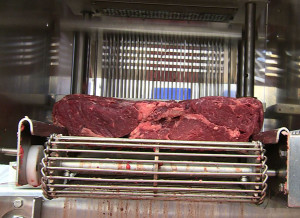Labelling regulations to take effect Aug. 21 are designed to protect consumers after the largest meat recall in the country’s history two years ago.
 Health Canada says beef that has been mechanically tenderized must have a sticker saying that.
Health Canada says beef that has been mechanically tenderized must have a sticker saying that.
Packaged steaks must also have cooking instructions that the meat must reach an internal temperature of 63 C and must be turned at least twice.
Health Canada says the rules are meant to ensure that tenderized meat is labelled from the processor to the consumer, since it’s hard to tell just by looking at it.
But Bruce Cran, president of the Consumers’ Association of Canada, said the cooking requirements are too complicated for most people and he wants mechanical tenderizing banned outright.
“What average Canadian having a beer and a steak is going to measure the temperature of the meat?” Cran asked.
Cran says irradiation of all meats is the best way to ensure meat is safe.
Health Canada received an application to irradiate ground beef, poultry, shrimp and prawns a decade ago, but a spokesman says the public was worried about the process.
Another application from the industry is under consideration.
Mark Klassen, director of technical services with the Canadian Cattlemen’s Association, supports irradiation but says mechanically tenderized beef is safe as long as it’s cooked properly.
Klassen said the association was involved in the research that supported the new labelling, including the cooking instructions. He says it also tested the labels with a sample of Canadians to make sure they were understandable and practical.
He said the research determined that earlier Health Canada instructions to bring the meat to the same internal temperature as ground beef, 71 C, made the beef tougher. He said 63 C is safe as long as the meat is turned at least twice.
